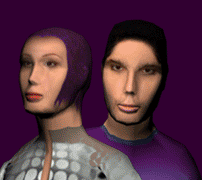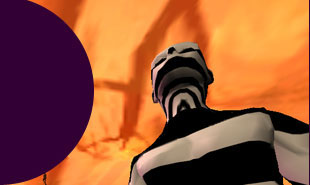
MOVIE
>
ABOUT >
Game + Team >
SCREENSHOTS >
Installationview
>


| fluID - arena of identities: June 2003, Graz/ A |
| |
||

|
MOVIE
>
|
 |
 |
||
|
Mirrors Mathias Fuchs "I'm dead now!" is obviously a statement, that contravenes the laws of classical logics. Either one is dead or one speaks of death: to do both simultaneously, as Epicurus once pointed out, is nonsense. Game addicts, in other words dyed-in-the-wool gamblers with symptoms of obsession, are usually unable to distinguish between the representation of their game figures on the screen and themselves. Consequently, they are no longer in a position to separate life from death. Game freaks and their fellow players find nothing odd about the claim to be dead when the game comes to a close. This is not the result of a lack of linguistic sensitivity, nor a lack of logic, but the result of the highly serviceable form of identity augmentation. The player's biological persona merges with the electronic stimulation of the active person. This construction is serviceable because it increases the intensity of the linguistic experience, and because it allows one to be both dead and alive at the same time. However, this augmentation of identity is problematical with respect to classical percepts of identity. Certainty could emerge from identity at the latest with Descartes' attempt to see things "clare et distincte". Descartes' intellectual experiment was to conceive sensuous experience as the deception of a being (where "I" is merely conjured before me) that dissolves the moment that Descartes construed himself as a thinking being. It is only with the aid of this construct that Descartes could dispel the doubts that he was being deceived by a god. In this way Descartes eliminated possible intermediaries (media) between himself and the world and creates the basis for the continuity of a personal "I", that everyone possesses and that everyone makes answerable for their deeds and thoughts. It was through Descartes' trick that ethics and a system of law related to individual people become imaginable. Clear guidelines to identity, however, are the price paid for the those rights, which bars the schizophrenics, the dreamers, the intellectually weak, the gamblers and the procrastinators. Some of these possess too much identity, the others too little - a luxury in one case, a defect in another. But one way or another an anomaly, that destroys the concept of a single identity. The non-identical threathens to undermine the enlightened, reasonable, non-Cartesian world and the gamblers - the game presents the concept of identity with a dangerous challenge. In the game the borders between the person and its environment dissolve. Roles, history, gender, ethnical identity and geograpy also blur in the game. This begins with "Cowboys and Indians" and ends with the Unreal Tournament, Quake or Final Fantasy. Bombproof
Identity Are there any visual elements that differentiate games from films or television and simultaneously act as catalysts for new forms of consciousness? I would like to submit the suggestion that the game mirror should be examined as an element that could be effective in constructing identity. Naturally, mirrors play an important role in cinematic history, but the mirror in the cinema remains constantly in the medium and does not divert the gaze to the viewer of the film. Computer games are more innovative in so far as the viewpoint of the viewer must not necessarily be predetermined by the medium. A game mirror is not identical to a film mirror. In early computer games one was tied to a third person view (Pacman, Super Mario) or first person view (Doom). More recent games on the other hand allow a choice of either of these two forms of presentation. Players report that they tend to identify more strongly with the game figures in third person shooters. The gaze from the eyes of the game figures prompts one's consciousness to a degree of identification and an intensity of identification that is different to a perspective that views the game terrain god-like from above. I maintain that the installation of feedback views, as can be found in mirrors and closed-circuit cameras in games, can introduce a further increase in complexity. Important steps in this direction were already implemented by video art and early computer art. However, I will try to prove later that video art was bound to reach a limit that computer games are now in a position to overcome. Self-Celebration In his study of the functions of interactive artworks the Canadian David Rokeby finally arrived by way of metaphors of navigation and discovery to the mirror. Media that - in contrast to the mirror of glass - do not reflect anything in their path in indentical form, would have to be called "transforming mirrors" in David Rokeby's terminology. In contrast to proverbial wisdom of "just as you shout into the forest, so will it echo back", the transforming mirror changes the form and figure of the mirrored. Rockeby found transforming mirrors in interactive technical processes and in interactive art. Rockeby differentiated between the usage of transforming mirrors from that of flat ones, by the fact that in the first case the "interactor" does not recognise his movements as being purely distorted, displaced or compacted but medially. Thus, the active recipient experiences himself as the subject experiences itself during dream work, the media assume the role that Freud assigned to the dream. "The interactor sees some representation of himself or herself like a mirror image or shadow, transformed by the potential with which the artist has endowed the space.." Rokeby cites his own work "Very Nervous System" as an example of a transforming mirror. In "Very Nervous System" a camera digitalizes the image of the interactors and transforms this pictorial information in a matrix of grey tones and then transfers the data to pattern recognition algorithm that produces sounds from the movements of the interactor. The transforming operation of the "mirror" in this case of this installation lies in the quantification of the image, its translation into grey tones and the medial translation into the area of sound. Rokeby describes the objective and function of interactive art as follows: By providing us with mirrors, artificial media, points of view and automata, interactive artworks offer us tools for constructing identities - our sense of ourselves in relation to the artworks and, by implication, in relation to the world". While Rokeby wants to present us in his installation with a (even if transforming) mirror, other artists are less willing to supply us with the mirror as a functionally efficient tool. Autonomous
Mirror Deception
and Trick Mirror Mirror
Things Mirrors also surface as decoration, spatial elements and architectural features. The warp zones in Unreal, in which I can met myself as a player and the Camera Clients from UT2003 structure space as a manneristic self-referential mirror space that is turned in on itself and in which I can implosively fall in on myself. It seems to be that the interior spaces of the psyche and the indentities and to be, that seem to have a greater attractiveness for the games world at the moment than the extraterrestial colonies of the '80s. The mirror
spaces of the games are the visible gameplay articulation of an idea.
The French author Jaques Rigaut (1899-1929) called that type of object
whose single objective is to mirror, mirror things: Ultra-Dandyism One can call the spatial objects of these new games mirror things and contrast their mimetic perfection with the cold stimulation of architecture, bodies and physics that had so enthralled us in past decades. It could be that one reason for the search for mirror images might lie in a dissillusionment with the unmirrored, constructed reality. It could be that we see self-fabricated reality as being not elegant and beautiful enough, and for this reason look for mirror reflections and the view inwards - even in games. One could even cynically claim that an industry that is continually avidly seeking innovation is presenting us with the mirror as a topical and trendy form of binoculars. Hence, with reference to this technology one would have to concur with Hegel when he stated: "Technology appears on the scene, when necessity arises". (transl. David Gogarty)
|
|
|